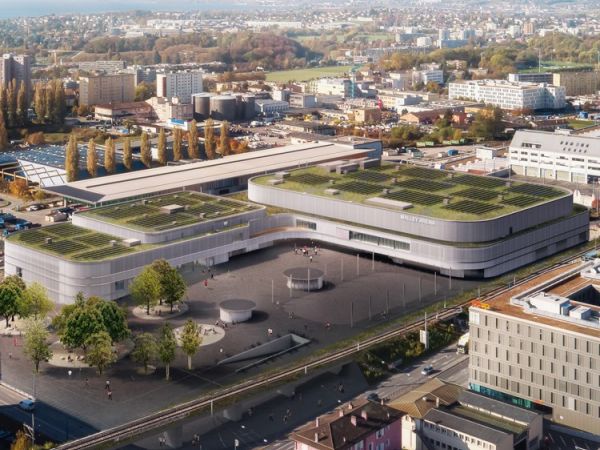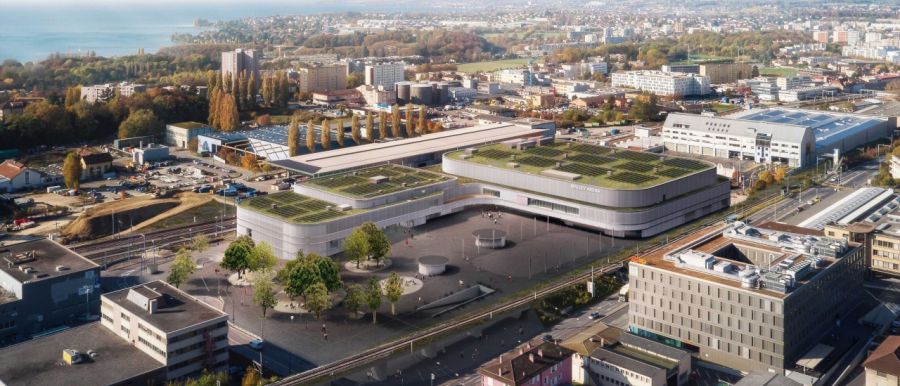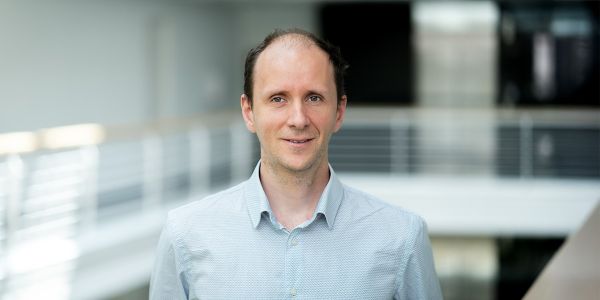

- 3.2 GWh of high-temperature heating requirement per year
- 3.4 GWh of low-temperature heat requirement per year
- 4.1 GWh total cooling requirement per year
- 690 kWp PV output for self-consumption
- CO₂ savings of 1,230 tonnes per year
The impressive sports centre in Lausanne Malley includes three ice rinks and four swimming pools – from a paddling pool for the little ones to a 50-metre Olympic pool. Services industriels Lausanne (SiL) and ewz’s energy solutions have founded a separate company, LaZur Energie SA (LaZur stands for ‘Lausanne Zurich’), to develop and implement the energy solution. LaZur will finance, build and operate the heating and cooling systems for the new stadium. The two companies have combined their expertise in the new company LaZur: while SiL coordinates legal and administrative matters, we are contributing our technical expertise to the development of sophisticated energy solutions.
Using waste heat instead of letting it just disappear
At the heart of the Vaudoise Aréna are the ice rinks and the large ice arena, which can accommodate up to 10,000 spectators. A lot of cooling is required for ice production and to keep the ice surface at a maximum temperature of –6°C. ‘When cooling is produced, there is always waste heat,’ says our project manager, Catherine Martin-Robert. ‘However, we also need a lot of heat for the other installations. This combination makes an extremely efficient energy solution possible,’ explains project manager Catherine Martin-Robert.
Five cooling machines produce cooling in the energy centre. ‘The resulting waste heat usually goes unused into the environment via the heat exchangers on the roof, but here it is different,’ explains Martin-Robert. The heat generated can be utilised easily elsewhere in the stadium. Some of the waste heat is therefore used directly to heat the rooms. More of it supports the operation of the two heat pumps, which are also located in the control centre. As the waste heat is already at a high temperature, it is possible to operate the heat pumps extremely efficiently. The systems work so efficiently that just a small amount of electricity from renewable sources is sufficient to heat the air in the swimming pool hall to the required level of 55°C (high temperature). The daily hot water requirement of up to 45,000 litres, which is used for showers and other things, needs to be heated to a temperature of 60°C.
District heating covers peak times
District heating from the local grid comes into play during peak loads. If the water in the swimming pool needs to be replaced, district heating is also used for this. This happens once or twice a year. The fresh water then has to be brought back to normal operating temperature within 72 hours – in the Olympic pool, this is usually between 25°C and 28°C. According to calculations the district heating requirement for this is around 2,100 MWh per year. The waste heat utilisation (direct and indirect via heat pumps) is around 4,600 MWh. According to Catherine Martin-Robert, our sophisticated waste heat utilisation concept can cover around 70 per cent of the total heating requirement, with the rest coming from district heating.
20 km of glycol pipes for each ice rink
The ice production system is also very interesting. To ensure optimal integration of the entire cooling production into the energy concept, LaZur is also responsible for the construction of the transmission lines for the glycol network, the insulation and the pipework. The ammonia cooling machines cool a dense glycol network of more than 60 km in total and keep the temperature of the 60 x 30 m ice rinks at the desired temperature. The ice master is responsible for maintaining the ice. On peak days with several competitions, 30,000 litres of lukewarm water are needed to clean the three ice rinks.
Dehumidification
When lots of people are in a room, moisture is created, which can turn into an unpleasant haze. To dehumidify the arena, cool air of 4°C is blown into it. According to Catherine Martin-Robert, the challenge was to find the right balance between cold and heat so that visitors enjoy maximum thermal comfort and do not feel draughts.
Homemade electricity
Some of the electricity for the new sports stadium comes from the two photovoltaic systems on the roofs of the indoor swimming pool and arena. Contractor LaZur has 190 kWp available for energy production, which can cover around 20 per cent of the energy centre’s total electricity requirement. 500 kWp output is intended for the remaining consumers, such as ventilation or lighting. If more electricity is required than the systems produce, renewable electricity is drawn from the grid. Around 80 per cent of the energy required for heat is produced from renewable sources or waste heat. Cooling production is 100 per cent carbon-neutral. This saves around 1,230 tonnes of CO₂ per year.
Optimal operation
Our specialist team uses a monitoring system to check the systems and optimise them on an ongoing basis. ‘Every pump and every machine is put through its paces under real conditions to keep energy consumption as low as possible,’ explains Catherine Martin-Robert. The aim is to use as little district heating as possible and to release only an absolute minimum of unused waste heat into the environment. LaZur is responsible for the optimisation, maintenance and operation of the energy systems for 30 years.






